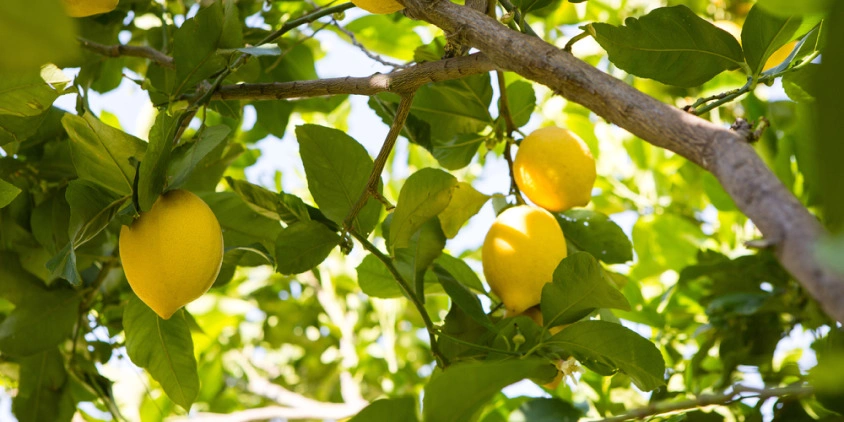
Growing A Lemon Tree Orchard: Planting, Care & Harvest
Growing lemon trees commercially is a long-term commitment: typically 18–30 years before replanting an orchard. Thus, setting up a new commercial orchard requires careful planning. Selecting the appropriate crop varieties and growing site, as well as laying out the orchard properly, are key first tasks.
Providing proper care for lemon trees in their early years is critical for the orchard’s long-term success. Later, disease management and general orchard maintenance practices significantly influence the established orchard’s lifespan. Using online crop management tools can help citrus producers choose the right lemon growing site and operate their orchards efficiently for maximum yields and useful lifetime.
Ensuring Optimal Growing Conditions For Lemon Trees
Lemons grow best in warm, sunny climates given well-drained soil. While they can tolerate some shade, direct sunlight is essential to grow healthy and abundant fruit. It’s important to protect growing lemons from strong winds and hail, which can compromise the quality and yield of the fruit.
Well-Drained Soil
Well-drained, medium-textured, and moderately deep soils are ideal for growing lemons. The trees prefer light loams or sandy loams with good drainage because they cannot tolerate waterlogging, potentially causing root rot. Thus, avoid low-lying growing areas prone to standing water.
The suitable lemon tree soil pH falls between 5.5 and 7.5, though the plant can adapt to slightly more acidic or alkaline conditions. Regular soil testing allows growers to make necessary amendments to maintain the best growing medium for fruit production.
Warm And Humid Environment
Citrus orchards thrive in warm, subtropical growing regions. Lemon trees grow best at daytime temperatures from 77°F to 86°F (25°C to 30°C) and nighttime temperatures from 55°F to 65°F (13°C to 18°C). Temperatures below 25°F (-4°C) can harm immature plants. Soil temperatures of 75–77°F (24–25°C) help roots grow actively.
Lemon tree sun requirements are 6–8 hours of direct daily exposure. Lemon tree growing zones with low rainfall of 30–100 inches (750–2500 mm) and distinct summers favor citrus cultivation. Humidity levels should be maintained around 50%; regularly misting the leaves can help reduce moisture loss and increase overall humidity around the tree.
Protection From Hail And Wind
Wind and hail impact the lemon growing process and directly cut into growers’ profits by damaging fruit quality. Wind pushes fruit against branches, leaving marks that make fruits unsellable as premium grade. Hail is even more detrimental — it can destroy young fruits entirely and leave lasting scars on mature fruits.
Smart orchard layout is the key defense against these threats:
- lemon tree rows need to align with prevailing winds to minimize fruit-branch contact;
- windbreaks — rows of taller trees growing around or within the orchard — provide additional protection.
Getting this layout right requires solid weather data. EOSDA Crop Monitoring gives crop producers access to over 20 years (for some locations, over 40 years by request) of local wind and hail records for their specific lemon growing location. This data, with five-year averages showing consistent patterns rather than one-off weather events, helps plan both row direction and windbreak placement.
Commercial growers can analyze the weather data directly in our smart agriculture cloud platform or download detailed XLSX reports covering wind speed, precipitation, humidity, soil moisture (surface and rootzone), evapotranspiration, temperature, NDVI, and more parameters to better guide their orchard design decisions.

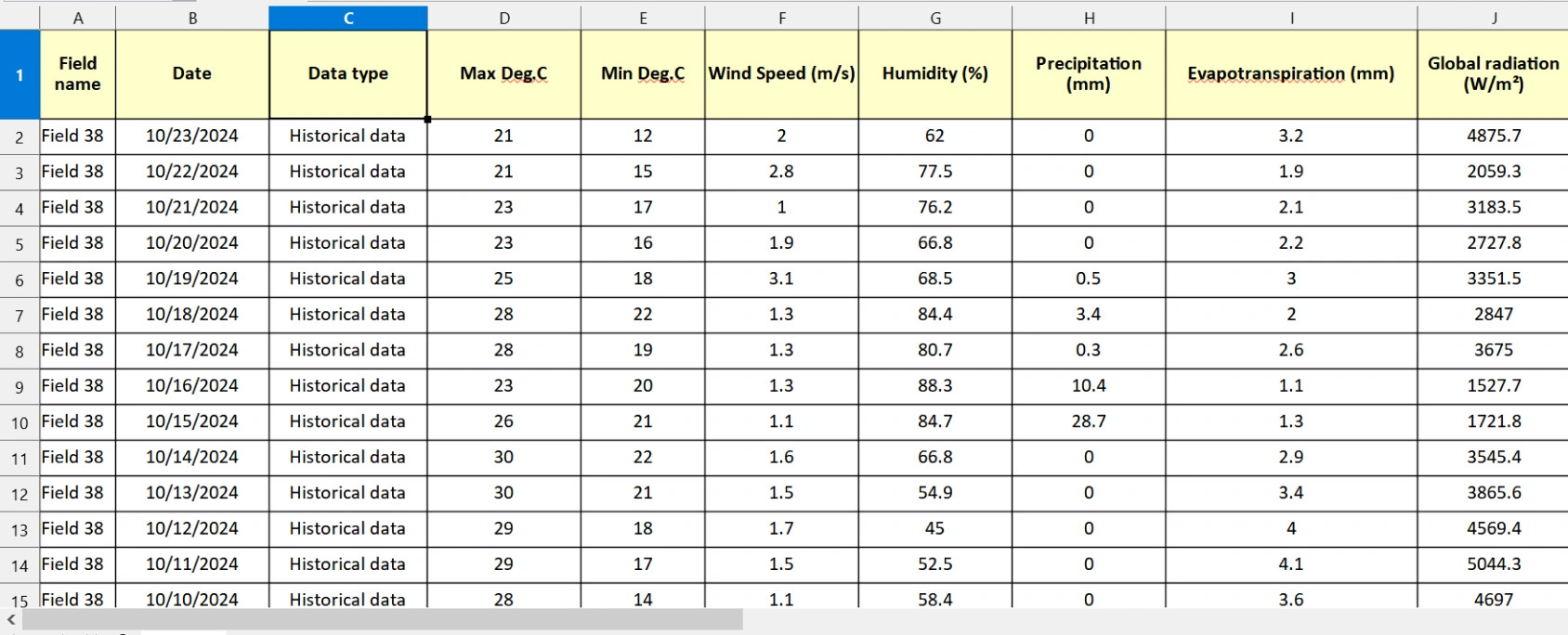
Once you’ve set up the right lemon tree growing conditions, it’s time to pick the variety that matches your fields and needs.
Choosing Lemon Tree Variety To Grow
Cold tolerance and transportability are the two most important criteria for selecting a lemon tree variety to grow:
- Meyer varieties have decent cold tolerance (in USDA hardiness zones 7 and lower, they still need anti-cold protection) and adapt well to container growing. But their softer fruit makes them less suitable for large-scale shipping. These lemon varieties work best for local market sales and specialty products.
- Eureka varieties, with their high yield and year-round fruiting, stand out for commercial production in warm tropical or subtropical growing regions outside the Mediterranean Basin . However, their extreme cold sensitivity means the need for anti-cold covering at temperatures below 20°F (-7°C).
- Lisbon varieties are most versatile for commercial lemon growing operations, combining high cold and drought tolerance with sturdy fruit that ships well. Their resilience to harsh weather and strong winds reduces the need for protective measures in different growing zones.
Now that we’ve covered how to choose the variety to grow, let’s explore the next steps of establishing your lemon orchard.
Choosing And Preparing The Field For Lemon Tree Planting
Choosing a site with ample sun, adequate drainage, and the right relief is the base for growing healthy, productive lemon trees. If you are planting in a place with a previously growing orchard, clear and prepare the area beforehand. When making holes for planting and spacing the trees, accommodate their future root and canopy growth.
How To Choose The Right Site For Plantation
The land’s relief is one of the key factors in the success of the orchard. Growing lemon trees tolerate sloped terrain quite well and, in some cases, may even benefit from the natural wind protection provided by slopes. However, the presence of slopes must be accounted for when planning the irrigation system. Using tools like EOSDA Crop Monitoring’s Slope or Elevation maps can help agriculture professionals assess the relief of a potential growing site in advance.
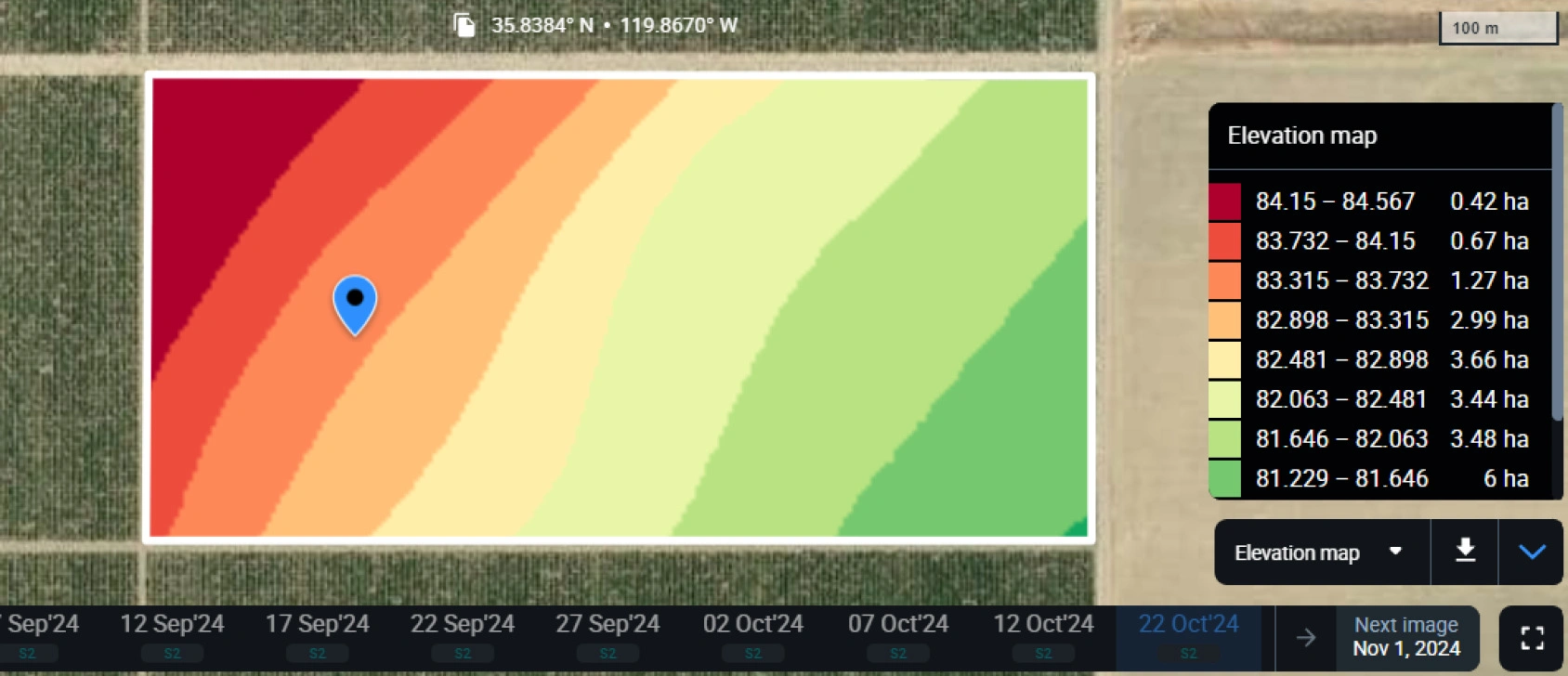
Another important factor to evaluate in lemon growing is soil moisture. The advanced soil moisture solution by EOSDA can provide detailed insights into the root zone and surface soil moisture levels across a growing area. By planting on a site with the ideal moisture profile, growers can set their trees up for long-term health and productivity.
How To Prepare The Land And Soil For Planting Lemon Trees
Before establishing a new lemon orchard, the first step is to remove any previously growing tree crops on this land and thoroughly clear the site. Next, rip the soil to a depth of 4–6 feet (120–180 cm) to break up layering that could impede root and water penetration. Finally, disk the soil for growing lemon trees to get rid of large lumps and level the soil. These land preparation activities usually take place a year before planting.
When And How To Plant
Transplanting young lemon trees is the most common for commercial growing. Plant lemons in the spring once the frost is no longer a concern. Dig a hole that is twice as wide and as deep as the root ball so that roots can easily grow. To avoid water collecting around the trunk, make sure the top of the root ball is either level with or slightly above the soil surface.
Typical spacing is around 16 by 16 feet (5 by 5 m) or 20 by 20 feet (6 by 6 m). Different varieties require different spacing based on their growth habits and mature size. Depending on the exact spacing used, the resulting plant population is approximately 112 to 162 trees/acre (277 to 400 trees/ha).
To keep the soil moist after planting lemon trees, water thoroughly and then cover the soil with mulch. Newly planted trees need regular watering and careful protection from frost.
Caring For A Lemon Tree Orchard
Growing lemon tree orchards demand fewer resources and care than most fruit orchards. Success relies on systematic watering throughout the lemon growing season and regular nitrogen applications to support fruit development.
How To Water Lemon Trees
Before watering, check the soil moisture level — by the rule of thumb, if the top 2–3 inches (50–76 mm) feel dry, irrigate the orchard. Mature plants are relatively drought-tolerant, but they need watering during the active spring and summer growing and fruit production. Lemon tree water requirements decrease in the fall and winter when plants aren’t actively growing. Be cautious not to overwater, as this can lead to yellowing leaves, fruit drops, and root rot.
Newly planted trees need more frequent watering than mature ones, typically every 3 to 7 days.
Use EOSDA Crop Monitoring’s Field activity log for simpler lemon irrigation. Plan and document the watering schedule for each growing area, including the performer, rate, and any additional inputs. Beyond just watering the growing lemons, this log can become a centralized hub to plan all your field activities.
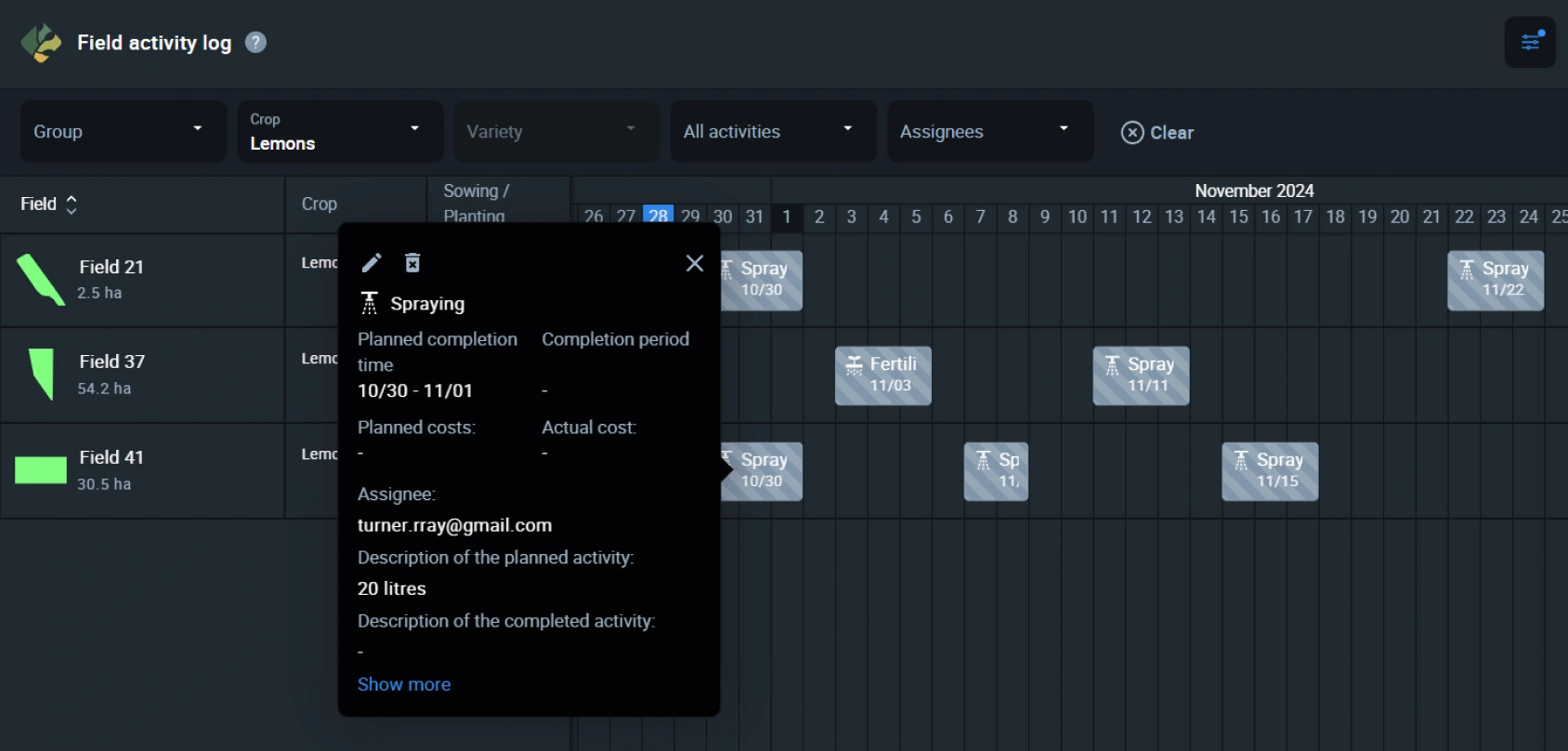
How To Fertilize Lemon Trees
Lemons require much nitrogen to grow healthy and produce a bountiful crop, supplemented by phosphorus and potassium in a 2:1:1 ratio. Micronutrients, particularly zinc and manganese, are crucial for preventing leaf yellowing and maintaining healthy yields . Monitor leaf coloration for deficiency signals throughout the growing season.
Young, growing plants are especially sensitive to nutrient timing and quantities. A typical fertilizer application schedule for lemon tree orchards might look like this:
- first year: deliver nitrogen through drip fertigation systems and apply foliar micronutrient sprays;
- second year onward: apply balanced NPK fertilizer twice–thrice from early spring through summer;
- third year onward: add soluble gypsum when irrigating.
Applying fertilizer evenly throughout different orchard growing zones can be a polluting factor and a waste of resources for large-scale crop producers. EOSDA Crop Monitoring addresses this issue through P&K VRA mapping technology, which analyzes multi-year NDVI data to identify distinct productivity zones. Fertilizer use at variable rates to different productivity zones throughout the orchard is far more efficient than flat-rate application.

How To Prune And Train A Lemon Tree
In the first five years of growing the orchard, limit pruning to sucker removal below the graft union and elimination of competitive water sprouts. Lisbon varieties need particular attention due to their vertical growth pattern. As trees mature, implement systematic lemon pruning and training:
- remove dead, diseased, or crossing branches;
- remove near-ground branches;
- control lateral growth to help canopy spread and fruits grow;
- pinch leaves to promote blooming;
- use espalier or open-center training for better space use and higher yields;
- install stakes to support actively growing young trees.
How To Control Lemon Tree Pests And Diseases
Growing lemon trees are constantly attacked by various pests, including citrus leaf miners, aphids, mealybugs, red spiders, scale insects, and mites. These pests can weaken growing trees and trigger premature fruit drop, directly affecting fruit quality and yield, while ongoing infestations can force farmers to replant trees or implement costly management strategies. To keep pests under control, regularly assess their populations and apply specific integrated pest management strategies based on established thresholds.
Beyond pest problems, growing trees may also suffer from numerous diseases throughout the lemon growth cycle. Below you’ll find detailed information about common lemon tree diseases, their telltale signs, and proven control methods.
| Disease | Symptoms | Control |
|---|---|---|
| Citrus canker |
|
|
| Melanose |
|
|
| Citrus scabs |
|
|
| Greasy spot disease |
|
|
| Citrus greening (HLB) |
|
|
| Gray mold |
|
|
| Phytophthora root rot |
|
|
Managing pest and disease risks in lemon plantations becomes more straightforward with the right tools. EOSDA Crop Monitoring offers a practical set of features to help protect your growing lemon trees.
Start with vegetation monitoring to detect potential health issues. Choose from over 10 vegetation indices, including NDVI, or request a custom index for your specific needs. Access default Sentinel-2 10m-resolution imagery with 3–5 day updates or upgrade to Planet’s 3m-resolution daily imagery for more detailed monitoring.
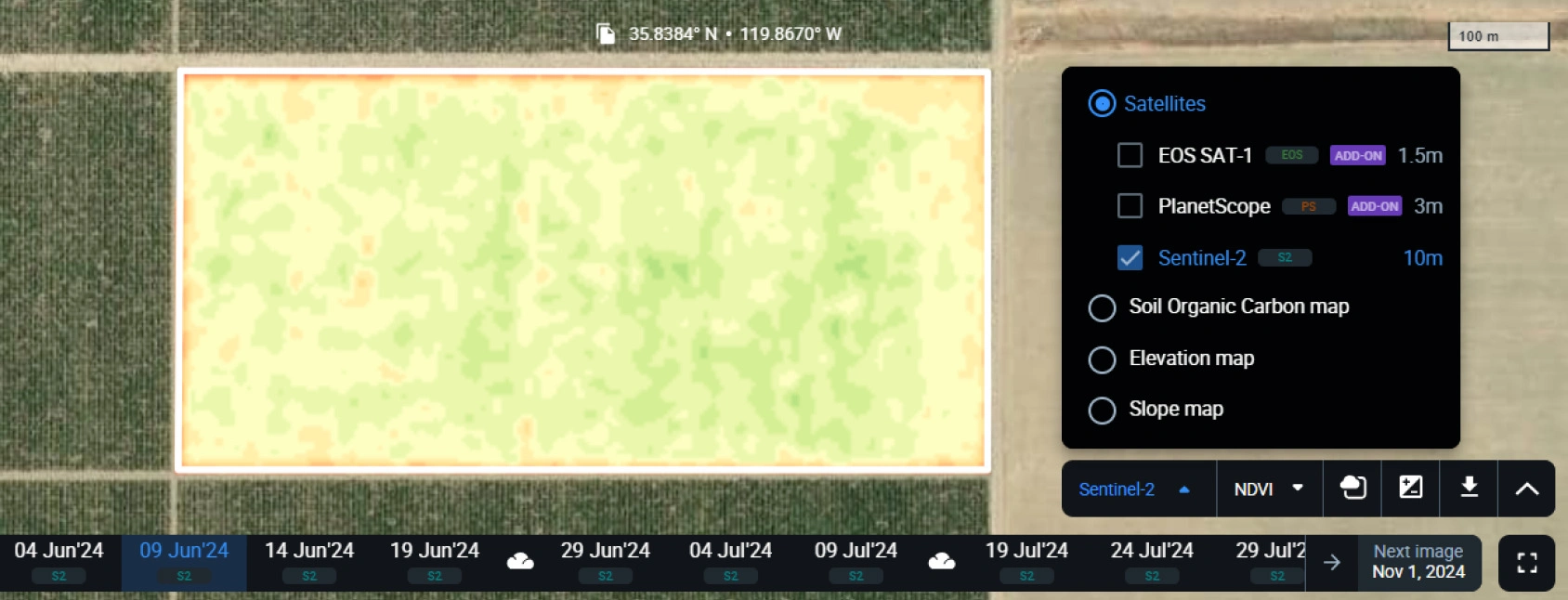
When vegetation monitoring flags potential problem areas, use our Scouting feature to investigate efficiently. Mark problem areas on the map, assign a scout, and set inspection deadlines to check for a particular problem. Instead of walking entire plantations, your scouts will focus on specific trouble spots, which is good both for your wallet and the trees’ health. Scouts submit detailed reports with threat assessments, photos, and specific findings for each problem and plantation — all in one place.
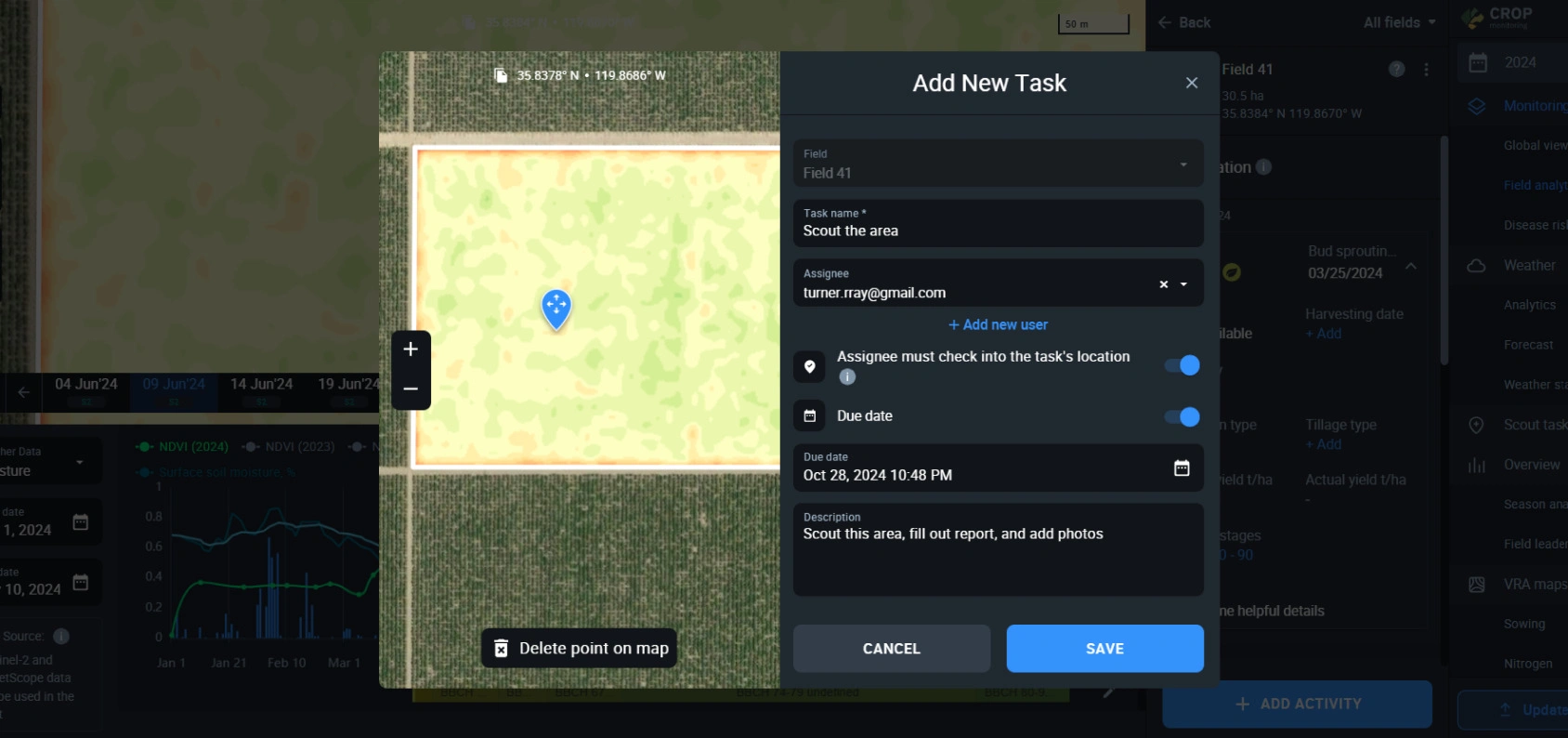
Moreover, the Disease Risk feature analyzes weather data and growth stages to warn you about potential disease outbreaks when growing oranges, lemons, and other common citrus trees.
How To Protect Growing Trees From Frost
Growing lemon trees typically demand frost protection during late winter and early spring, when they are most vulnerable. Effective protection combines traditional field methods and advanced monitoring systems to prevent cold stress and frost damage. Time-tested protective methods include:
- keeping orchard floor bare or with low vegetation to store daytime heat and release it in the night;
- watering the orchard floor to release heat when temperatures drop;
- using wind machines, one machine per 8–10 acres (3.2–4 ha), to mix warmer upper air with colder near-ground air around the trees .
Weather forecasting directly impacts protection success. EOSDA Crop Monitoring can alert growers when temperature, wind, or precipitation readings approach dangerous levels, which is particularly valuable for managing multiple lemon orchards across different growing locations. This lets farm managers cut response time and save harvests.
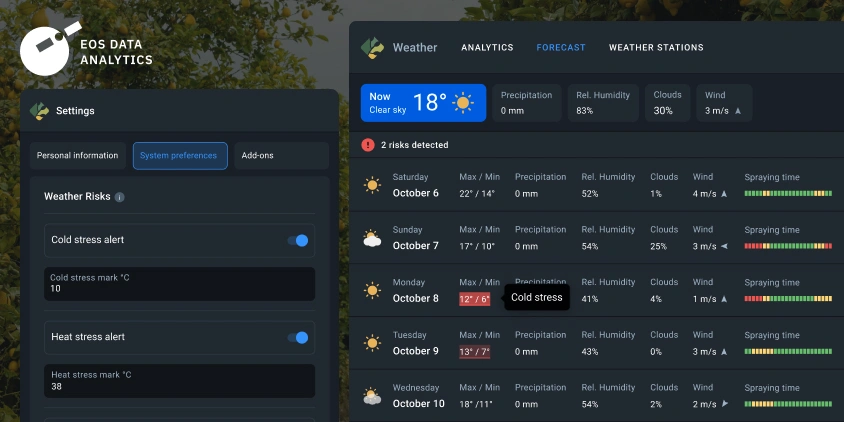
Lemon Tree Harvesting And Post-Harvest Fruit Treatment
Citrus trees start producing fruit 3–5 years after you plant them. Typical lemon harvest season lasts from late fall to early spring, sometimes allowing for a few harvests. Once the tree flowers, it takes 5–6 months (depending on the variety and growing conditions) for fruits to become ready to pick. You should let lemons ripen on the tree since they won’t ripen after picking.
Harvest lemons when they turn yellow or yellow-green (for example, for the Valencia varieties) and grow to the size of 2–3 inches (5–7.6 cm). Harvesting should occur at peak fruit color and, more crucially, flavor.
Commercial growers employ two main approaches to harvesting their crop, which vary based on the machinery and labor availability, as well as the need for selective harvesting:
- Manual harvesting. Trees are harvested by cutting fruits off with pruning shears or clippers or by pulling the fruit stalk from the tree. This method allows for selective picking and minimizes fruit damage.
- Mechanical harvesting. Fruits are harvested using specialized agricultural equipment, including contact machines with picking arms and mass-removal machines that shake the tree trunk. Both systems incorporate catch frames to collect fallen fruit. This method is more efficient on a large scale but doesn’t allow for selective picking.
Careful post-harvest handling prevents bruising and extends shelf life. Remove any damaged or infected fruit, then wash and sort the remaining fruit so it is ready to store. To prolong their freshness, store fruits in a well-ventilated facility at 50–55°F (10–13°C). Following these lemon tree planting, growing, and storage practices ensures crop producers a bountiful harvest of high-quality citrus fruits marketable for months.
About the author:
Vasyl Cherlinka is a Doctor of Biosciences specializing in pedology (soil science), with 30 years of experience in the field. He attended the engineering college in Ukraine and received his degree in agrochemistry, agronomy and soil science in the Chernivtsi National University. Since 2018, Dr. Cherlinka has been advising EOSDA on problems in soil science, agronomy, and agrochemistry.
Recent articles

Analyze 2025 & Plan Your Best Year Yet: LandViewer Christmas Offer
It’s the most wonderful time of the year! The Christmas holidays are here, and so is your chance to analyze 2025 and plan a prosperous 2026 with more affordable Pro plans in LandViewer.

EOSDA Models Climate Change Impact On Sugarcane Yields
EOSDA modeled future temperature, rainfall, and other climate impacts on Veracruz sugarcane. The results help growers plan long-term adaptation strategies, including timing, varieties, and irrigation.

EOSDA LandViewer Black Friday Sale: Exclusive Offers & Giveaway
This Black Friday, LandViewer offers new users the chance to save on monthly plans, get extra months with yearly subscriptions, and participate in a free annual plan giveaway.